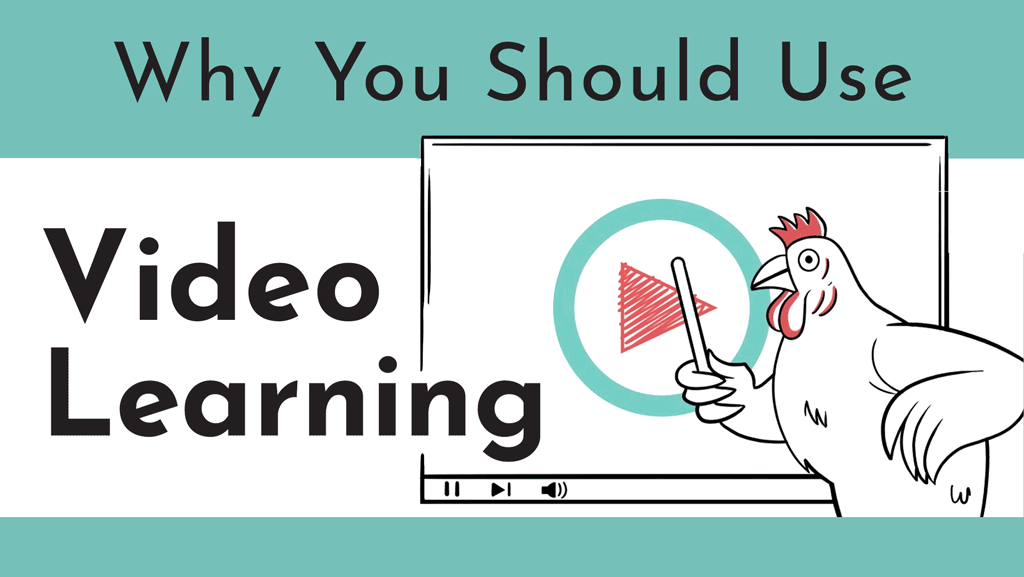
Video Learning is – you guessed it! – using video to teach knowledge or skills.
You were using video learning when those YouTube tutorials helped you fix your leaky faucet. And it was video learning at work when you recreated that TikTok dance with your dog!
Video learning can be used for so many things. Although, we admit that dancing with your dog is probably second to none.
Animation is incredibly effective in almost any learning scenario, including hybrid learning, corporate training, and so much more. If you aren’t already leveraging video learning, it’s time to start!
Here are some common problems that are easily solved with video learning.
Problem: Mandatory trainings are boring.
We know, we know – #NotAllMandatoryTrainings. But a lot of them. Enough that your team probably has an aversion to them.
Or maybe you are responsible for teaching an important concept. How do you keep lessons engaging when there is a lot of technical jargon or details that can weigh down the material?
Solution: Video Learning makes your message enticing!
Animation has the power to bring things to life. Video’s ability to synergize important facts with illustrative visuals is one of the main reasons why you should use video learning: video lessons make your audience truly engaged in learning.
Engaging multiple senses leads to stronger mental connections and long-term retention. Video learning helps things stick.
Check out this video we created with the American Kidney Fund. Although defining extremely complex rare kidney diseases like IC-MPGN, C3G requires a lot of details, the syncronicity of the animation and vocabulary help the viewer cement the most important messages about what the diseases are and how they effect your kidneys.
Whether you are teaching electrical engineering, using video to explain a new payroll system, or fulfilling compliance requirements, your audience is more likely to carry what they learned forward if they watched it in a video.
Detailed policy documents or articles are necessary in many cases, and seem like a clear way to share detailed information. Unfortunately, though, the science shows that the chances of everyone reading it are slim to none.
Get a quote right now on a video tutorial, instead. Or there’s always that seventy-slide PowerPoint presentation. Everyone loves those.
Problem: Consistent messaging is hard, and time-consuming.
Maybe you have a global workforce that speaks many different languages. Maybe you have employees with disabilities that make in-person or on-paper trainings inaccessible. Or maybe you need information about a new policy or program to go out asap, and want to prevent a big game of telephone.
Solution: Video Learning makes your message accessible and consistent.
Video learning provides the same opportunities, access, and messaging to workers all over the world, including remote workers, speakers of different languages, and employees with visual impairments or who are deaf.
Audio Description, as seen in this animation we created with Guide Dogs for the Blind, is a form of narration used to provide information surrounding key visual elements in a media work for the benefit of blind and visually impaired consumers. Follow this link to see another project we created with Guide Dogs.
The content of a video is the same no matter where it’s viewed. With translations, subtitles, closed captions, audio descriptions, and mobile-friendly formats, videos can be made accessible to everyone anywhere. And best of all, we can make a video as fast as you need us to, to reach your audience right when they need it. Read about our rush projects here.
Problem: Trainings are expensive. Learning materials are hard to update!
There’s no replacement for a dynamic guest speaker. But budgets don’t always allow for that option – especially if things need to be custom-tailored to different teams, locations, languages, or topics.
And any teacher knows how hard it is to keep paper materials as up to date as you’d like them.
Solution: Animation is flexible.
Video is an engaging alternative with a high ROI. Cost effectiveness is an additional benefit of video learning that goes hand-in-hand with the accessability discussed above.
A video can easily be updated each quarter or each year as your data changes, but your core message and mission stay the same. And with animation, details can always easily be tweaked, added or updated as things change – no need for reinventing the wheel (or re-printing an entire syllabus!)
And when it comes to trainings or sharing inforation about policies, video is far less expensive to send to your employees than a thick envelope of paper, and it’s less expensive than getting all your employees in one place. You don’t have to choose between an engaging training that will break the bank, or a less expensive one that people won’t care about. Video is the engaging training at a reasonable cost.
Video learning is useful for teaching skills to your team or explaining concepts to learners.
In this example, Ednovate leverages the power of video learning to ensure their practioners across LA and Orange County recieve consistent messaging about Development Conversations.
Problem: Teams are spread out.
These days, we’re all thinking a lot about what we are able to do in-person and what we are able to accomplish from the comfort of home. You shouldn’t have to exclude anyone from the full learning experience you want to give.
Solution: Video learning meets people where they are.
Animation is perfect for hybrid learning and remote work. Video learning can be used to accommodate both hybrid and in person learners simultaneously, and even provide a point of interaction and team-building.
We’ve seen clients incorporate interactive elements to make learning more interactive. Things like check-points, quizzes, and discussion questions bring trainings to life and bring audiences’ focus to the topic at hand.
Use your video both to teach… and unite as a team around a shared goal, question, learning, or mission.
Video tutorials, video lessons or e-learning are great resources for teachers or instructors who are building lesson plans in this new world of hyrbid learning. Knowing that your learners are all experiencing the same, engaging content makes it easier to connect and share ideas as a group.
You’re ready to use the power of video learning to share your message effectively!
Solution: Next Day Animations
Are you ready to learn more about video-learning? Our friendly client advisors are looking forward to brainstorming your big idea. Call any time at 202-747-0404, or click here to schedule a call.


